White Pines Survey Trip
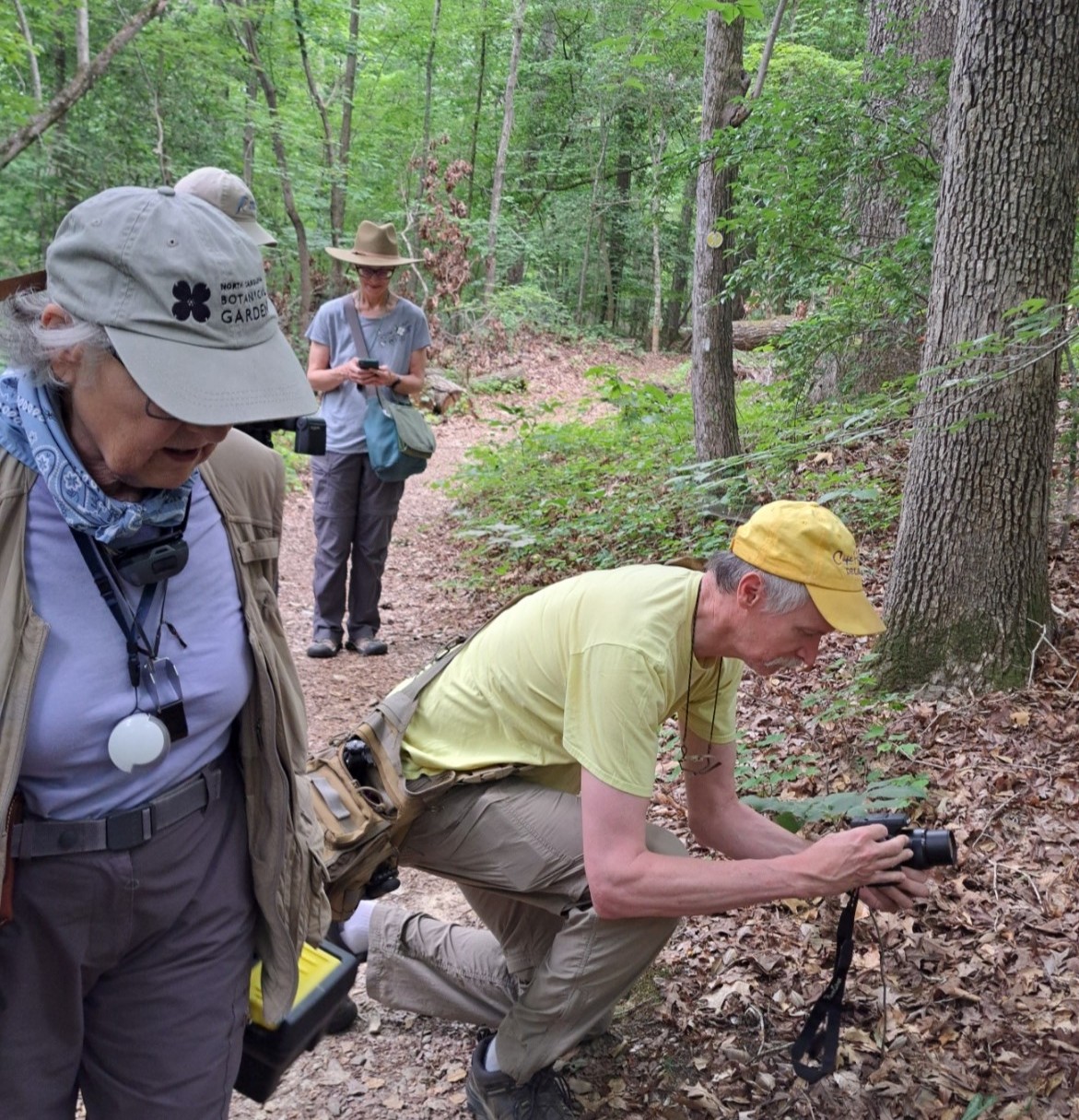 Since the start of our year-long biodiversity survey at White Pines Nature Preserve in May, we have been making frequent trips to the preserve to catalog all of the various life forms present. On Sunday, June 16, we made a group trip which included day and night sessions.
Since the start of our year-long biodiversity survey at White Pines Nature Preserve in May, we have been making frequent trips to the preserve to catalog all of the various life forms present. On Sunday, June 16, we made a group trip which included day and night sessions.
Day Survey
NCBP members Jame Amoroso (bryophytes), David George (moths), Meriel Goodwin (myxomycetes), Jason Hollinger and Gary Perlmutter (lichens) met at noon on a relatively hot, humid day, with temperatures in the mid-80s. We were joined by Jame’s husband John Amoroso, who works for NC State Parks. While we stayed together for much of the day, we were all focused on our own narrow ecological niches for the survey. For this post, we will provide updates on our different findings.
Lichens (Gary Perlmutter and Jason Hollinger)
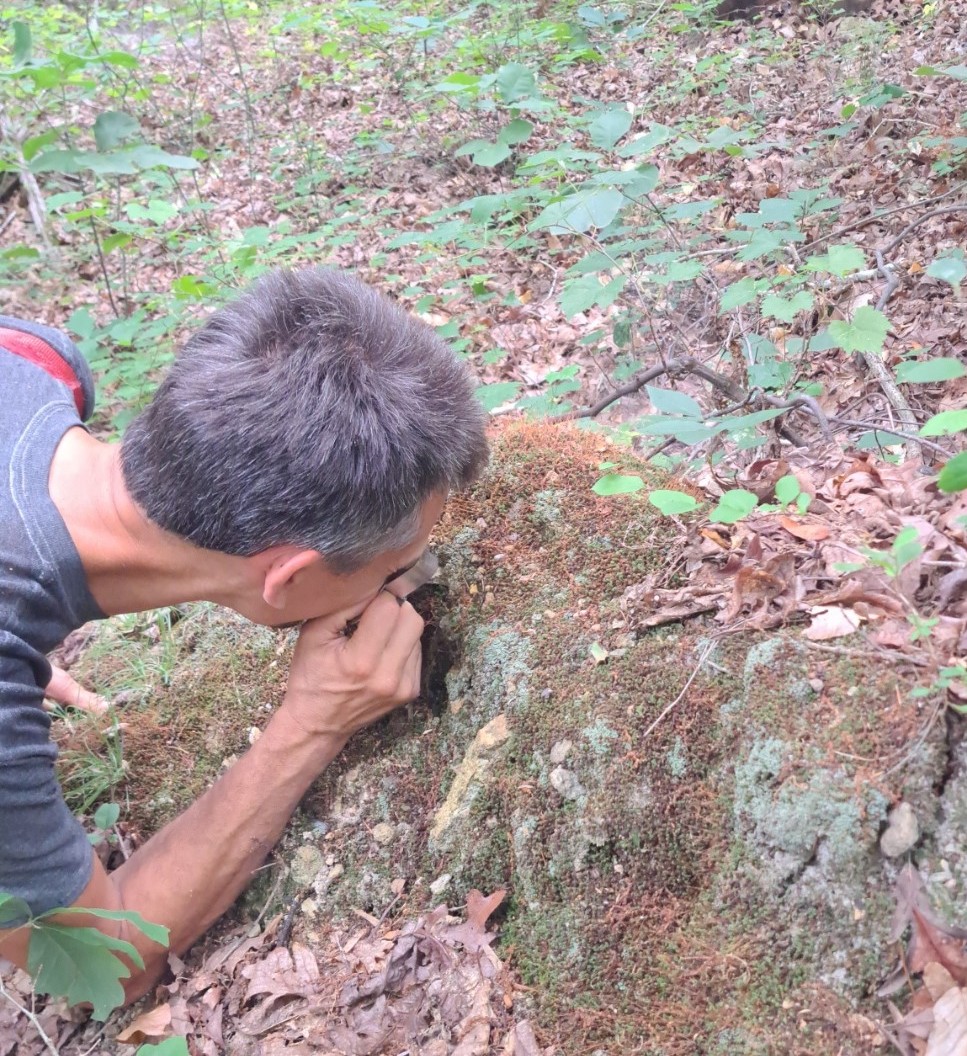
Jason was the first to arrive, coming from the Outer Banks and took the time to collect in the nearby forest. The rest of the group arrived more or less on time. While waiting for more folks to show, Gary joined Jason in collecting lichens from the abundant fallen tree branches in the parking area. This was to capture the lichen diversity of the forest canopy.
We embarked on Schoolkids Trail to the NW, generally following the same paths encircling the preserve that we had walked on our scouting visit back in April, and taking notes, photos, and specimens along the way. We looked for lichens growing on any available substrate, including rocks, soil and down logs of the forest floor as well as exposed roots, trunks and low branches of trees, both live and dead, standing and fallen. Gary relocated the white crust on the base of the large holly tree by the pond he spied on the scouting visit, and found it to be Nadvornik’s Pale Dot Lichen (Nadvornikia sorediata), which is common in the Piedmont and a Chatham County record. Another noteworthy white crust he relocated and collected along the trail appears to be a white Dictyomeridium proponens growing on a beech tree at about midslope toward the river. Near the base of the slope near the Rocky River was a dark rock grotto, which was lined with the green curious lichen Flakea papillata, which had befuddled biologists for decades and earned the name The Thing.

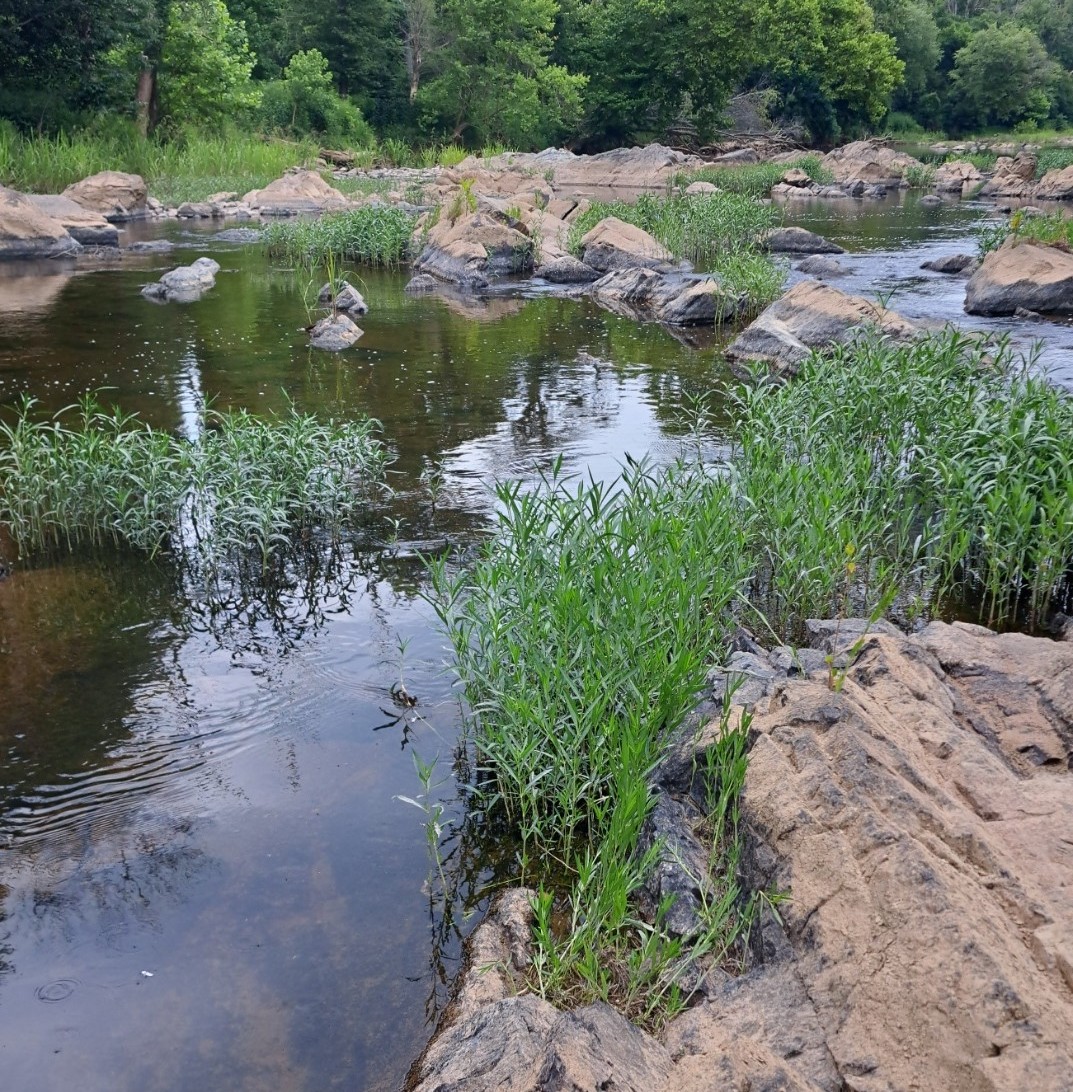
At the Rocky River, Jason and Gary went upstream to explore the river lichens while the rest of the group continued along the trails. With the river at low base flow height as it hadn’t rained in over a week, the lichen team observed and collected from three zone lichen communities both along the shore and up the steep, near vertical, rocky bank as well as on exposed channel rocks in the middle of the river. Noteworthy finds include a gray foliose jelly lichen (Leptogium?) growing on low rocks near the bank, and the common Fluvial Black Rosette Lichen, which appears to be an undescribed species of Pterygiopsis that is currently under study by an expert in Germany. Many of these river taxa are unique and their discovery shines a light onto the complex ecology of stream lichens that surprisingly has received little attention outside of Europe. Jason spied an orange Squamulea lichen on an exposed channel rock and collected a specimen to sequence its DNA to see if it too is a new species. Having lost the rest of the group, Jason and Gary encircled the preserve via the River and Gilbert Yaeger trails, arriving at the parking area after everyone else had left.
The lichen team has begun processing their collections and observations, but many remain to be fully identified. Our current total for the preserve is about 75 species. As only a portion of the preserve was surveyed, this number is expected to grow.
Slime Molds (Meriel Goodwin)
Since myxomycetes emerge after recent rains, unlike May's Spring Flush where they were flourishing in most of the Preserve, on last weekend's now dry slopes myxos were largely absent. The exception was several sightings of NC's most ubiquitous slime, the unstoppable yellow/brown Fuligo septica, aka "dog vomit" to its young friends. It takes a number of different forms; David's excellent photos capture the most common.

Once down on the bottomlands (chigger territory!), I did find some of the more frequent taxa folks might encounter this summer in wetter areas of WPP:
Arcyria cinerea: tiny white, grey or beige helmets, frequent in the sodden wood piles near the rivers. Like Fuligo septica it also appears in various guises.
Arcyria denudata: a red cousin of Arcyria cinerea. Of a number of similar looking taxa, this is the most common one so far in WPP.
Hemitrichia calyculata: another wet log/trunk lover, particularly visible in its immature form, a series of small, shiny, orange dots. Mature, it is golden and bushy haired.

Metatrichia vesparia: aptly named since it resembles tiny wasp nests, sprouting red hair. More frequent on bark, and often in later summer.
Stemonitis fusca. One of about 20 taxa superficially resembling each other, all called, for obvious reasons, "chocolate tube slime" in popular parlance. On drier decorticated wood or bark of all sorts.
Stemonitis splendens: Diva of the Stemonitis clan, long haired and dramatic. Not frequent. David's photo shows we found a perfect specimen.
Absent from Sunday's slime sightings were the very common white stalked Physarum golbuliferum, usually preferring drier sites, and any members of the Cribraria genus, such as the "chinese lantern" Cribraria cancellata, often found in extensive fruitings on damp fallen gymnosperm trunks.
Like us, myxos prefer undisturbed areas and varied micro habitats, so White Pines Preserve is an ideal location. In just a few weeks in late May I found almost all the 25 or so taxa most characteristic of the Piedmont, and even a few NC rarities such as Cribraria argillacea.
Although they are not strictly seasonal, many slime mold genera flourish selectively at different times of year, so I expect to keep adding many more to the total list as we make further survey visits.
Moths (David George)
There weren’t many moths to be seen during the daytime excursion, but I did find some leaf mines and a couple caterpillars. I always enjoy spending time in the field with experts in taxa I don’t know as much about, and am always eager to learn more about the hidden worlds on the surfaces of rocks and trees. Mostly I served as the roving photographer, being called over by Gary and Meriel to take pictures of the lichens or slime molds they were finding. I tried to stay hydrated and not overly exert myself, as I would be at the preserve until late that night.
Bryophytes (Jame Amoroso)
Although this was not my first visit to White Pines Nature Preserve, this was the first visit for the Biodiversity Project survey of the preserve. The focus for bryophytes will be to document the liverworts and hornworts of the preserve and to re-document the 65 or so mosses that were surveyed in 1975-1976 by Robert Meyer, a student of noted Duke bryologist Dr. Lewis Anderson.

During this preliminary visit, I spotted several common mosses that are field identifiable such as Atrichum angustatum, Bryoandersonia illecebra, Climacium americanum, Dicranum condensatum, Entodon seductrix, Haplohymenium triste, Platygyrium repens, Ptychomitrium incurvum, Thuidium delicatulum and others. These observations re-document about 12% percent of Meyer's 1976 list. Future field surveys will focus on species that need microscope work to identify.
As for the liverworts, only a few had been collected before such as the ubiquitous Cheilolejeunea (Leucolejeunea) clypeata. I collected a patch that was already peeling off of an American Holly tree that was growing intermixed with Frullania ericoides, now new to the White Pines checklist. Another common species throughout the state that I can add to the checklist is Nowellia curvifolia, a tiny liverwort that grows on decorticated logs. In this case it was on the trunk of a downed white pine. I also collected a ribbon-like liverwort, Metzgeria from a rock near the river.
I anticipate many more liverworts will be added to the list during future survey visits.
Night Survey (David George)
For our nighttime session, I was joined by Steve Hall, along with Patrick Coin, a longtime contributor to BugGuide and an excellent nature photographer, and Mark Basinger, a biology professor at Barton College who has become a major submitter of records to the Moths of NC website. I set up three sheets with UV lights at upland sites along the River Trail, including one I hadn’t previously sampled at on a steep bluff above the Deep River. We saw many interesting insects on the sheets, and for the most part the experience was quite enjoyable. The major exception being the yellowjackets that assaulted us at one of the sheets, and even followed us to another sheet. All of us suffered multiple stings, and I unfortunately learned that I have developed an allergy to their stings, as my arm became quite swollen over the following days.
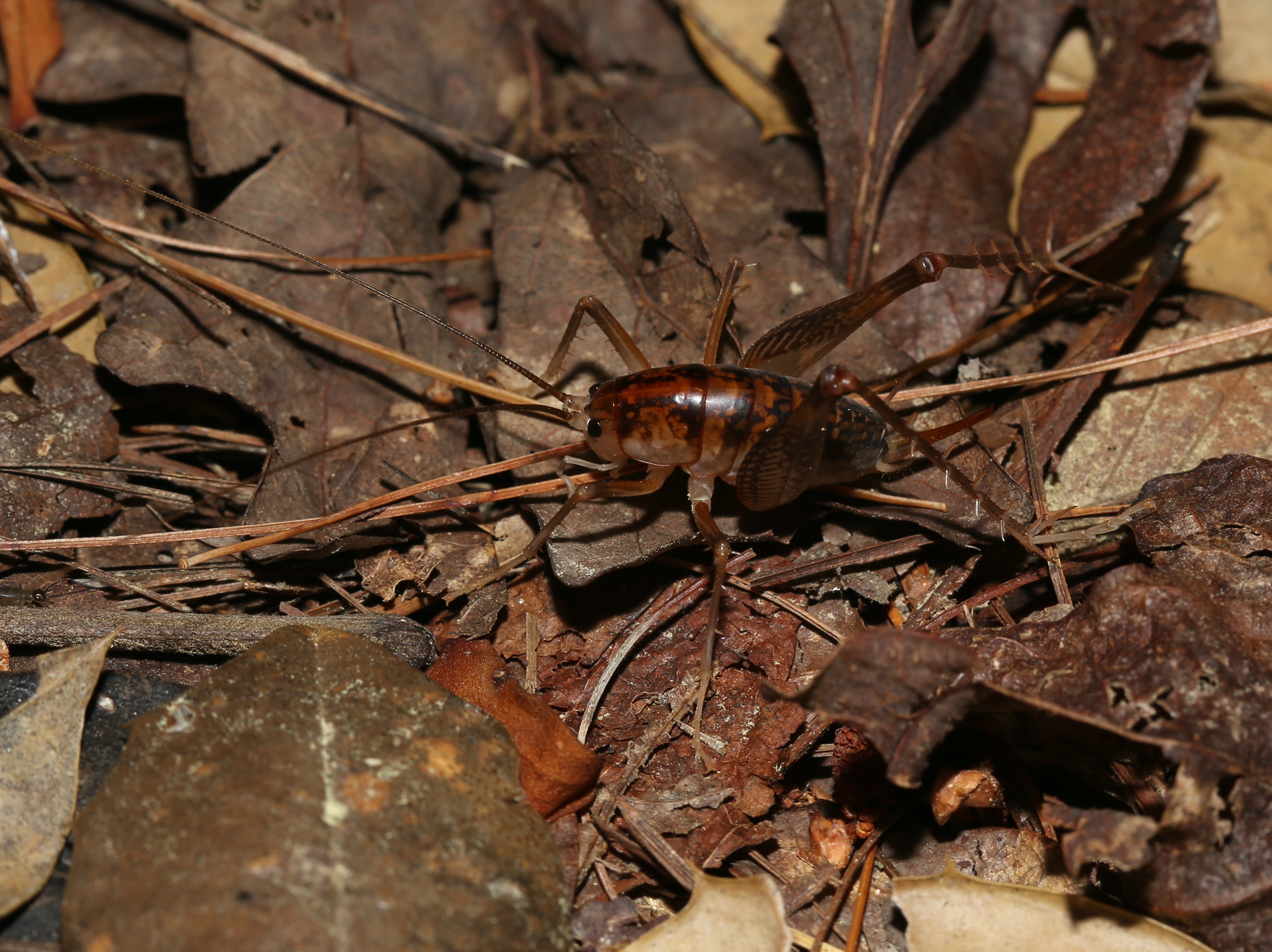
Steve spent much of his time on sound recordings, which are particularly useful for documenting the elusive singing creatures of the night, including birds, amphibians, and orthopterans. He was somewhat disappointed not to hear any Whip-poor-wills or owls, but did make some nice recordings of several species of frogs. (Update: I did hear Whip-poor-wills the following weekend). Most exciting was a camel cricket which he and Patrick discovered on the trail, which Steve has tentatively identified as Ceuthophilus maculatus. If confirmed, the species would represent a major Pleistocene relict, and a surprising disjunct population from where it has previously been documented in the north. But Steve notes that there aren’t a lot of people looking for camel crickets, or who are qualified to identify them.
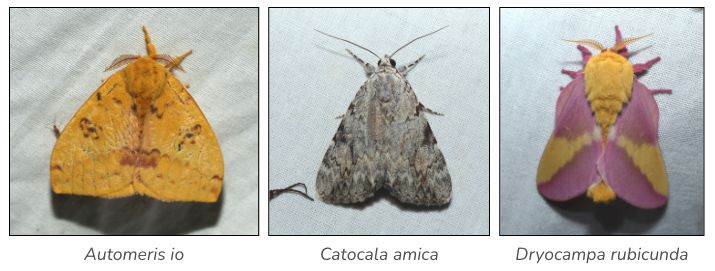

We added several new species of moths to our list for the preserve, which has already exceeded 500 species (and it isn’t even summer yet)! White Pines is proving to have exceptional diversity in terms of moths and all of the other groups we have been looking at. Some of the highlights on the sheets included an Io Moth (Automeris io), a Girlfriend Underwing (Catocala amica), and several Rosy Maple Moths (Dryocampa rubicunda). In all, we recorded 105 species of moths on and around the sheets, along with many other interesting insects, including the Giant Stag Beetle (Lucanus elaphus) pictured to the left.